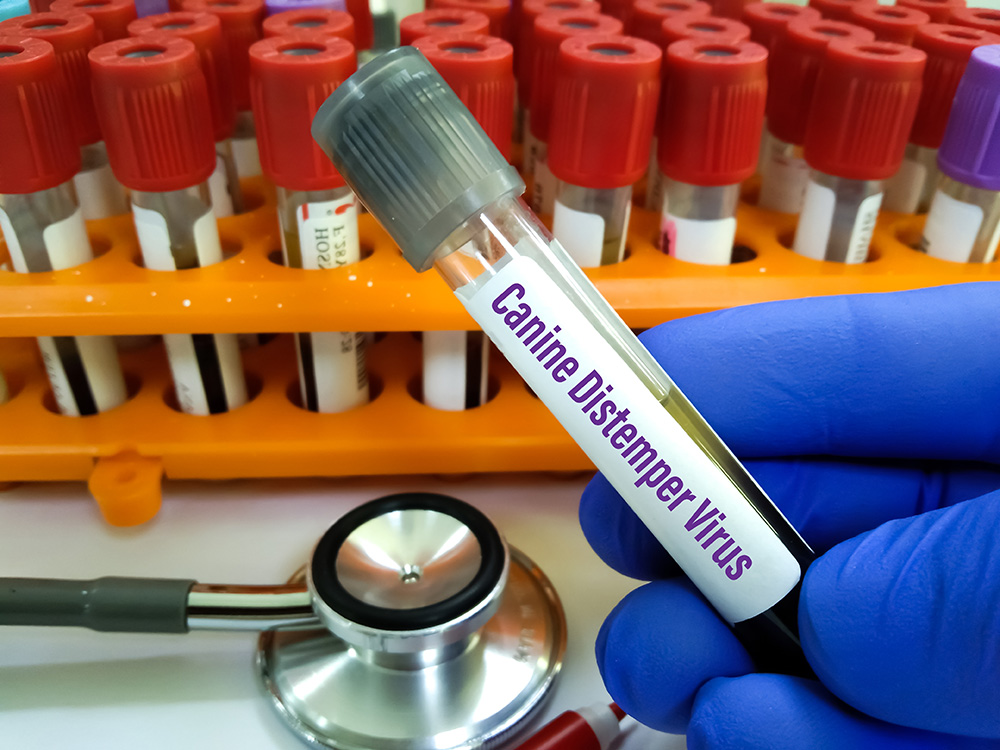Click to Skip Ahead
If you’ve ever seen your dog have a seizure, you know how horrible it can be. Most of the time, a seizure lasts less than a minute, but it can feel much longer, and it’s totally normal to feel helpless and scared. Seizures can occur for many different reasons. It might be a one-off event, a reaction to something they’ve eaten, a sign of illness, or the start of a seizure disorder. You’re going to want to know what caused your dog to have a seizure in the first place and what to do about it, so the first thing you’ll need to do is get in touch with your vet. The next step is to learn a bit more about seizures, which is what has brought you here.
We’re going to take a look at everything you need to know about seizures in dogs, including what conditions can cause them, how they are treated, and what signs you should be on the lookout for.
What Is a Seizure?
A seizure, or fit, happens when there is uncontrolled electrical energy between the brain cells (AKA neurons). Depending on the underlying cause, a seizure could last seconds, minutes, or even longer. They can be an isolated episode, happen in groups, or become a regular occurrence. Seizures are categorized based on how they present, which you’ll see in the following:
Generalized or Grand Mal Seizures: The most common type of seizure affecting dogs. It affects all or most of the body and usually includes:
- Muscle trembling or twitching
- Vocalizing (barking, yelping, crying)
- Collapse with loss of consciousness or responsiveness
- Loss of control over bladder/bowels
- Paddling of the limbs
- Frothing at the mouth, champing of the jaw
Focal Seizure: Also known as partial or localized seizures, they affect a single limb or part of the body with twitching or trembling. These are uncommon in dogs and usually indicate a focal lesion or mass in the brain.
Absence Seizures: Also known as “petit mal,” these seizures present as “spaced out” behavior, gazing at nothing, and unable to respond to stimulus until the seizure has ended. These can be difficult to recognize, as the dog may show no other clinical signs, so they are sometimes mistaken for dementia or hearing/vision loss.
Seizures can also be characterized based on the time period over which they occur, including:
Single/Isolated Seizure: May progress to other forms or may just be a one-off episode. A true isolated seizure is more likely to be triggered by an external influence, such as a toxin or high temperature, or a transient chemical imbalance, such as low blood sugar (hypoglycemia) or low calcium (hypocalcemia).
Cluster Seizures: Refers to two or more seizures within a 24-hour period.
Seizure Disorder/Repeated Seizures: For example, epilepsy, where more than two seizures over a longer period of time.
Status Epilepticus: Seizures that last more than 5 minutes, or repeated seizures without a gap or period of consciousness between them.
Refractory Seizures: When seizures keep occurring despite the use of anti-seizure medication. Seizures may be refractory from the start or progress over time as the condition becomes resistant to medication.
What Are the Causes of Seizures in Dogs?
Seizures can occur for many reasons, and sometimes, especially in the case of a single, isolated seizure, we never find out the cause. Below are 10 potential causes of seizures in dogs, starting with the most common.
1. Epilepsy
There is no specific test for epilepsy, and it is only diagnosed when all other causes of seizures have been ruled out. For this reason, it is also called idiopathic epilepsy because the actual cause is unknown. However, scientists believe that there is an inherited disorder that causes a chemical or functional imbalance that leads to seizures in affected dogs.
All breeds can get epilepsy, but some are more commonly affected than others, including Border Collies, Labradors, and Golden Retrievers. Seizures usually start to occur when dogs are between 6 months and 6 years old and will generally affect them for life.
In most cases, epilepsy can be successfully managed with medication, but over time, we often need to increase their dosage or add additional medications. The drugs used to treat seizures are also sedatives, so the aim of managing epilepsy is to stop or minimize the frequency and severity of seizures without causing excessive sedation, so it’s not unusual for a dog on epilepsy medication to still have an occasional seizure.
Once treatment has started, it is dangerous to withdraw it, as this can trigger severe and frequent seizures. Apart from causing sedation, anti-seizure medications can have other side effects, particularly on the liver, and patients are only started on treatment if their seizures are quite frequent, severe, or long lasting, and dogs on medication should have regular blood tests to monitor their liver function.
2. Low Blood Sugar
Hypoglycemia can trigger a seizure and may be seen in very young or malnourished dogs. One cause of hypoglycemic seizures in dogs is a tumor on the pancreas called an insulinoma, but it can also occur as a result of liver failure, certain toxins (e.g., xylitol), or insulin overdose.

3. Brain Tumors
Although brain tumors are often benign, the very limited amount of space inside the skull leaves little room for expansion. This means that a mass growing in the brain will eventually start to put pressure on the surrounding tissues, causing different signs, depending on what part of the brain is affected, and seizures are quite common.
4. Toxins
Any substance that negatively affects the electrical or chemical processes in the brain can cause seizures. Some toxins may affect the brain directly or cause disruption indirectly by affecting other organ systems. The types of toxins that may result in seizures include:
- Poisons, such as antifreeze, rat bait, or pesticides
- Biological substances, like venom/toxins found in plants or animals
- Food additives/ingredients, such as xylitol, chocolate, or salt
- Heavy metals, such as lead and zinc
- Illicit drugs, such as cocaine, methamphetamines, and cannabis
- Medications

5. Metabolic Disorders
This refers to diseases that affect how the body metabolizes food and other substances. If the liver or kidneys are unable to filter out waste products or harmful substances correctly, they can have a toxic effect on the brain, leading to seizures. Examples include portosystemic shunt, periparturient hypocalcemia of dogs with new puppies, and renal failure.
6. Heart Disease
If the heart is not functioning properly, it can result in reduced blood flow or cause clots to form in the blood vessels supplying the brain. This can starve the brain of oxygen (hypoxia), resulting in seizure activity.

7. Inflammatory Disease
- Granulomatous Meningoencephalitis (GME): Seen most commonly in smaller breeds, such as Chihuahuas, Miniature Poodles, or small Terriers, GME is the inflammation of particular brain cells.
- Meningitis: Inflammation or infection of the cerebrospinal fluid (CSF). The most common form in dogs is idiopathic or steroid-responsive meningitis, while bacterial and viral meningitis are rare.
8. Infection
- Protozoal: Neospora and Toxoplasma are protozoal organisms that can cause neurological signs, including seizures. Most infections are mild and quickly fought off by a healthy immune system, but immunocompromised or very young animals can develop a more serious illness and require treatment.
- Bacteria or Viruses: Some infections, such as Canine Distemper, can produce neurological signs, such as seizures, directly. Other times, seizures occur as a result of a high fever caused by the immune response to infection.
- Fungal: Cryptococcus, a fungal infection spread in bird feces, is usually asymptomatic in dogs but can cause seizures in immunocompromised individuals.

9. Fever
Although a fever is quite common in dogs that are fighting infection, if that temperature exceeds 106oF (41.1oC), it can lead to brain damage and seizures.
10. Heat Stroke
Dogs don’t sweat, which means their primary method of cooling down is through panting. When the temperature is hot, particularly in humid conditions, this cooling mechanism is not very efficient. If a dog cannot cool their body down quickly enough, organ failure, brain damage, seizures, and even death can be the result.

How Do I Care for a Dog With Seizures?
If your dog is having a seizure, the most important (and hardest) thing to do is not panic. Assess the area around your dog for any possible hazards (sharp, pointy objects or somewhere they might fall), and make sure your dog is safe. If you need to move them, do so very carefully, as a dog that is having or recovering from a seizure can behave aggressively.
The best place for a seizing dog to be is somewhere cool, dark, and quiet, but only move them if you can do so safely. If you think they might be suffering from heat stroke, wet a towel and place it over their body.
If possible, try to time the length of the seizure, and even take a video to show your vet. When you can, make a list of any foods or substances your dog may have been exposed to, and look around for anything else that could have triggered the seizure.
Phone your vet for advice as soon as you can and they will advise you about what to do next. Depending on the history and circumstances, they might ask you to stay at home and monitor your dog, bring them in straight away, or make an appointment to come in for an examination and blood tests.

Frequently Asked Questions (FAQ)
Are Seizures Dangerous?
They can be. Some of the time, the real risk is from what is causing the seizure itself, but if a seizure lasts for longer than 5 minutes or so, permanent brain damage can occur. Because a seizure causes the muscles to twitch and contract uncontrollably, this can lead to an increase in body temperature, which can cause damage to the organs and brain. This is particularly risky when the cause of the seizures is fever or heat stroke.
Dogs can injure themselves on objects around them or bite their tongue during a seizure. They can also bite or injure us when they are disoriented, so you always need to be careful around a seizing dog, even one that wouldn’t normally hurt a fly.
Are Seizures Painful?
The seizure itself isn’t painful, but it can cause your dog to feel confused and disoriented once they recover. However, as we mentioned above, dogs can sustain injuries during a seizure that could be painful.
Does My Dog Know When They’re Going to Have a Seizure?
You may have heard of seizure alert dogs; an elite form of service dog that is able to detect an oncoming seizure and alert their owner. While a dog cannot be trained to detect a seizure, they can be trained to act on that awareness. However, not all dogs have this ability.
It is believed that seizures in humans produce a particular smell, and it is the dog’s superior olfactory sense that detects this change. It is certainly possible that dogs can tell that they are going to have a seizure, particularly if they have epilepsy and have experienced them more than once. We don’t know if this would be based on olfaction or other senses, but some owners do report that their dogs seem to become quiet or take themselves to bed or a quiet corner before they have a seizure.

How Can I Tell if My Dog Is Going to Have a Seizure?
The period leading up to a seizure is known as the pre-ictal phase, and this might last a few seconds or several hours. Most of the time, you get no warning at all, but if your dog has epilepsy, you might start to notice some signs that give you an indication that your dog is going to have a seizure, including:
- Hiding or going to a quiet corner
- Appearing anxious, licking lips, yawning, trembling
- Drooling
- Whimpering
If you notice any of these signs, make a note of the time, and make sure your dog is in a quiet, dark room with blankets and pillows around them.
How Can I Tell if My Dog Has Had a Seizure?
If your dog has epilepsy, you might be worried about them having a seizure when you’re asleep or out of the house. This can happen, and you may never know about it. However, some dogs can have quite a long post-ictal phase, and you might come to recognize some signs that suggest they have had a seizure. For example, your dog might seem sleepy, wobbly, or particularly clingy. There might also be evidence, such as objects knocked over or disturbed, as well as urine, feces, or vomit in the house.
If you are worried about leaving your epileptic dog, here are a few tips to maximize their safety (and your peace of mind):
- Invest in a pet camera.
- Confine your dog to one room in the home that has no sharp objects or anything they can knock over. Avoid crates, as they can get limbs or jaws stuck between the bars.
- Create a “seizure nest” for them with soft bedding and pillows.
- Turn off any bright lights.
- Consider playing a sleep sound or white noise device to reduce noise disturbance.
- Make sure you always have a ready supply of their medication.

Conclusion
Seizures are frightening for dogs and their humans and can be the result of anything that may disrupt normal brain function by damaging neurological tissue, damaging other organ systems which then affect the brain, or causing a dangerous elevation of body temperature. However, epilepsy is the most common cause of seizures in dogs. Fortunately, this is a condition that can usually be well managed with medication.
Although seizures can occur as isolated events and further investigation and treatment may not always be necessary, you should always contact your vet immediately if your dog has had—or is having—a seizure. Always be careful around your dog when they are having or have just had a seizure, as their altered mental state can cause them to act completely out of character. We hope this has helped you understand more about seizures in dogs, but remember to get in touch with your vet if you have any other questions or concerns.
Featured Image Credit: Przemek Iciak, Shutterstock











